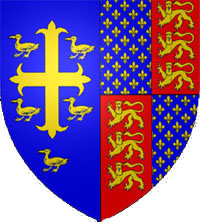 Given the deep connections between the two plays, it would be logical to assume that either Richard II was written as a sequel to Richard II: Thomas of Woodstock or that R2: Woodstock was written as a prequel to Richard II.
Given the deep connections between the two plays, it would be logical to assume that either Richard II was written as a sequel to Richard II: Thomas of Woodstock or that R2: Woodstock was written as a prequel to Richard II.
Since it’s comparatively more common for authors to write sequels rather than prequels, let’s start with that hypothesis. If Richard II was written as a sequel to R2: Woodstock, we would expect to see callbacks to the earlier play. In just such a fashion, Shakespeare in Henry V has the king pray to God to forgive the deposition of Richard II by his father; and in Richard III he explicitly builds upon the murders seen onstage during the Henry VI plays.
Richard II similarly seems to build upon R2: Woodstock. Take, for example, the Duchess of Gloucester. She appears in the second scene of Richard II, laments the loss of her husband in commiseration with the Duke of York, and then disappears from the play entirely. Why? From a dramatic point of view, her brief presence seems to contribute very little (if anything) to the narrative of Richard II.
On the other hand, the scene serves admirably as a bridge between Richard II and R2: Woodstock, where the Duchess is an integral and pervasive character throughout the play. Viewed in this light, her appearance neatly ties off the plot of the previous play and helps transition the audience into the new circumstances of the sequel.
The frequent references to Richard as the “landlord of England” in R2: Woodstock might also be an example of this. The epithet is deeply tied into the narrative of R2: Woodstock (which revolves around the “renting” of the kingdom to Bushy, Bagot, Green, and Scroop). In Richard II, where the “leasing” of the kingdom is barely mentioned, the “landlord” reference is used only once, by the Duke of Lancaster:
Why, cousin, wert thou regent of the world,
It were a sharm to let this land by lease;
But for thy world enjoying but this land,
Is it not more than shame to shame it so?
Landlord of England art thou now, not king.
The line is a memorable one, and its power and meaning can certainly be carried through performance even when an audience doesn’t really know what Lancaster is talking about. But can’t it also be read as a dramatist reminding his audience of the events they saw in the previous play?
On the other hand, there are aspects of the play which make Richard II‘s role as a sequel seem doubtful. The most egregious example is the character of Greene, who dies dramatically in the closing scenes of R2: Woodstock only to “reappear” without explanation in Richard II (only to be executed by Bolingbroke).
The death of Greene in R2: Woodstock is completely unhistorical (he was, in fact, executed by Bolingbroke), but that’s of little consequence. (Elizabethan history plays, like modern Hollywood movies “based on a true story”, are studded with historical inaccuracies for the sake of dramatic necessity.) What seems impossible, however, is that an author would write a sequel to their own work featuring a character they had killed off in the previous installment!
… right?
Actually, it’s not quite so clear-cut. Consider the example of Jurassic Park: In the novel written by Michael Crichton the character of Ian Malcolm (played by Jeff Goldblum in the movie) dies. In the movie, on the other hand, Ian Malcolm survives. And when Steven Spielberg went to make the sequel, he wanted it to star Jeff Goldblum. But he also wanted it to be based on a novel by Crichton. Which is why Crichton’s The Lost World stars the formerly dead Ian Malcolm and never really bothers explaining how that could be true.
Am I saying Shakespeare had a film deal? No. I’m just pointing out that continuity errors ““ even a continuity error as significant as ignoring the death of a character ““ aren’t enough to prove that Michael Crichton didn’t write The Lost World.
In the case of Greene, there are any number of hypothetical possibilities: The actor playing Green could have proven popular enough to bring back the character. Our copy of R2: Woodstock could have been altered to include Greene’s dramatic death at a point where continuity with Richard II had become irrelevant. Or it could predate a rewrite which would have made R2: Woodstock more consistent with its sequel. Or perhaps the Shakespeare simply discovered he needed the character of Greene in Richard II and decided he didn’t care about the continuity problems.
Unfortunately, all of this speculation still leaves us at an impasse: Was Richard II written as a sequel to R2: Woodstock, building on its predecessor while recalling its dramatic arcs? Maybe. Was R2: Woodstock written as a prequel to Richard II, deliberately fleshing out material left undeveloped or merely evoked by the earlier play? It seems just as likely.
Originally posted on September 16th, 2010.











